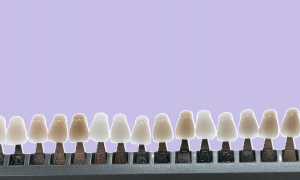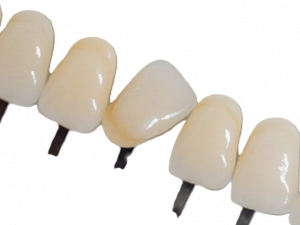Composite veneers have emerged as a popular choice in the field of cosmetic dentistry, offering individuals a non-invasive yet transformative solution for achieving a dazzling smile. We review composite veneers, exploring what they are, their advantages, drawbacks, the application process, costs, and how they compare to other dental veneer options. If you’re considering enhancing your smile, read on to discover the wonders and intricacies of composite veneers.
What are Composite Veneers:
Composite veneers are custom-made, tooth-colored shells crafted from a composite resin material that is applied to the front surface of your teeth. Unlike traditional veneers, which are typically made from porcelain and require the removal of a significant amount of tooth enamel, composite veneers are a minimally invasive option that bonds directly to the tooth’s surface.

Advantages of Composite Veneers:
Natural Appearance:
Composite veneers offer exceptional aesthetics. The composite resin used closely mimics the natural color and texture of teeth, ensuring a seamless blend with your existing dentition. This natural appearance is one of the key factors that draw people to this cosmetic dentistry solution.
Minimal Tooth Reduction:
Unlike porcelain veneers, which necessitate the removal of a substantial amount of enamel, composite veneers require minimal to no tooth reduction. This preserves your natural teeth and minimizes the discomfort associated with enamel removal.
Versatility:
Composite veneers can address a wide range of cosmetic issues, from discoloration and chipping to irregular spacing and misshapen teeth. Their versatility makes them a versatile option for many individuals seeking smile makeovers.
Immediate Results:
Composite veneers provide instant results. In most cases, a single appointment with your dentist is all that’s required to transform your smile, as the resin is applied and sculpted directly onto your teeth.
Repairability:
If your composite veneers become damaged or stained over time, they are easily repairable. Your dentist can quickly touch up or replace the affected veneers, ensuring your smile remains flawless.

Drawbacks of Composite Veneers:
Durability:
While composite veneers are highly resistant to staining and chipping, they may not be as durable as porcelain veneers. Over time, composite veneers may require more frequent maintenance or replacements.
Prone to Staining:
Composite resin is more prone to staining compared to porcelain. This means that you’ll need to be cautious about consuming foods and beverages that can cause discoloration.
Longevity:
The lifespan of composite veneers can vary, but they generally have a shorter lifespan compared to porcelain veneers. On average, you can expect composite veneers to last between 5 to 10 years.
Application Process:
Consultation:
The process begins with a consultation with your dentist. During this appointment, you can discuss your goals and expectations for your smile makeover. Your dentist will evaluate your oral health and determine if you’re a suitable candidate for composite veneers.
Preparation:
If you decide to proceed with composite veneers, your dentist will begin the preparation process. This typically involves cleaning and roughening the tooth surface to ensure a strong bond with the composite resin.
Bonding:
The composite resin is carefully applied to the prepared teeth. Your dentist will sculpt and shape the resin to achieve the desired appearance, making sure it matches the surrounding teeth seamlessly.
Curing:
After the resin is sculpted, it is hardened using a special curing light. This step ensures that the veneers bond securely to your teeth.
Final Touches:
Once the veneers are cured, your dentist will make any necessary adjustments to achieve the perfect fit and appearance. This may involve further shaping and polishing.

Comparing Composite Veneers to Other Options:
Porcelain Veneers:
Porcelain veneers are a more durable option, and they are less prone to staining. However, they require the removal of more tooth enamel and are typically more expensive.
Lumineers:
Lumineers are ultra-thin porcelain veneers that require minimal tooth reduction, much like composite veneers. They offer a long-lasting, stain-resistant solution but can be more expensive than composite veneers.
Dental Bonding:
Dental bonding is an alternative to composite veneers. It involves the use of a resin material to repair or reshape teeth. While it’s less expensive, it may not be as durable or natural-looking as composite veneers.
Composite Veneers FAQs
How long do composite veneers last for?
The lifespan of composite veneers can vary depending on various factors, including your oral hygiene habits, dietary choices, and the quality of the materials used. On average, composite veneers can last between 5 to 10 years. Regular check-ups with your dentist and proper care can help extend their longevity.
Are composite veneers a good idea?
Composite veneers can be an excellent choice for individuals seeking cosmetic enhancements to their smile. They offer a natural appearance, are minimally invasive, and can address a wide range of dental imperfections. However, whether they are a good idea for you depends on your specific dental needs and goals. Consulting with a qualified dentist is the best way to determine if composite veneers are a suitable option for your situation.
Are composites better than veneers?
The choice between composite veneers and traditional porcelain veneers depends on your individual preferences and dental needs. Composite veneers have the advantage of being less invasive, more cost-effective, and repairable. However, porcelain veneers are known for their durability and resistance to staining. Whether composites are better than veneers depends on your priorities and the advice of your dentist.
What are the disadvantages of composite veneers?
While composite veneers offer many benefits, they do have some disadvantages to consider. These include:
- Durability: Composite veneers may not be as durable as porcelain veneers, and they may require more frequent maintenance or replacements over time.
- Staining: Composite resin is more prone to staining compared to porcelain, so you’ll need to be cautious about consuming foods and beverages that can cause discoloration.
- Longevity: The average lifespan of composite veneers is around 5 to 10 years, which is shorter compared to porcelain veneers.
It’s essential to discuss these potential drawbacks with your dentist when considering composite veneers as a dental treatment option.
How much do composite veneers cost?
The cost of composite veneers can vary widely depending on several factors, including your location, the expertise of the dentist, the number of teeth requiring veneers, and the complexity of your case. On average, the cost of a single composite veneer can range from $250 to $1,500 or more. It’s crucial to schedule a consultation with a qualified dentist to get an accurate estimate tailored to your specific needs and location. Keep in mind that composite veneers are often more affordable than porcelain veneers, making them a cost-effective cosmetic dentistry option for many individuals.
Summing Up Composite Veneers
Composite veneers offer an accessible and minimally invasive path to achieving a radiant smile. Their natural appearance, versatility, and ease of repair make them an attractive choice for those seeking cosmetic dental enhancements. While they may not last as long as porcelain veneers and are more prone to staining, their advantages often outweigh the drawbacks for many individuals. If you’re considering a smile makeover, consult with your dentist to determine if composite veneers are the right choice for you. Your journey to a confident, stunning smile may be just one dental appointment away.
Composite Veneers References
The Success of Dental Veneers According To Preparation
Customized composite veneers from a totally digital workflow